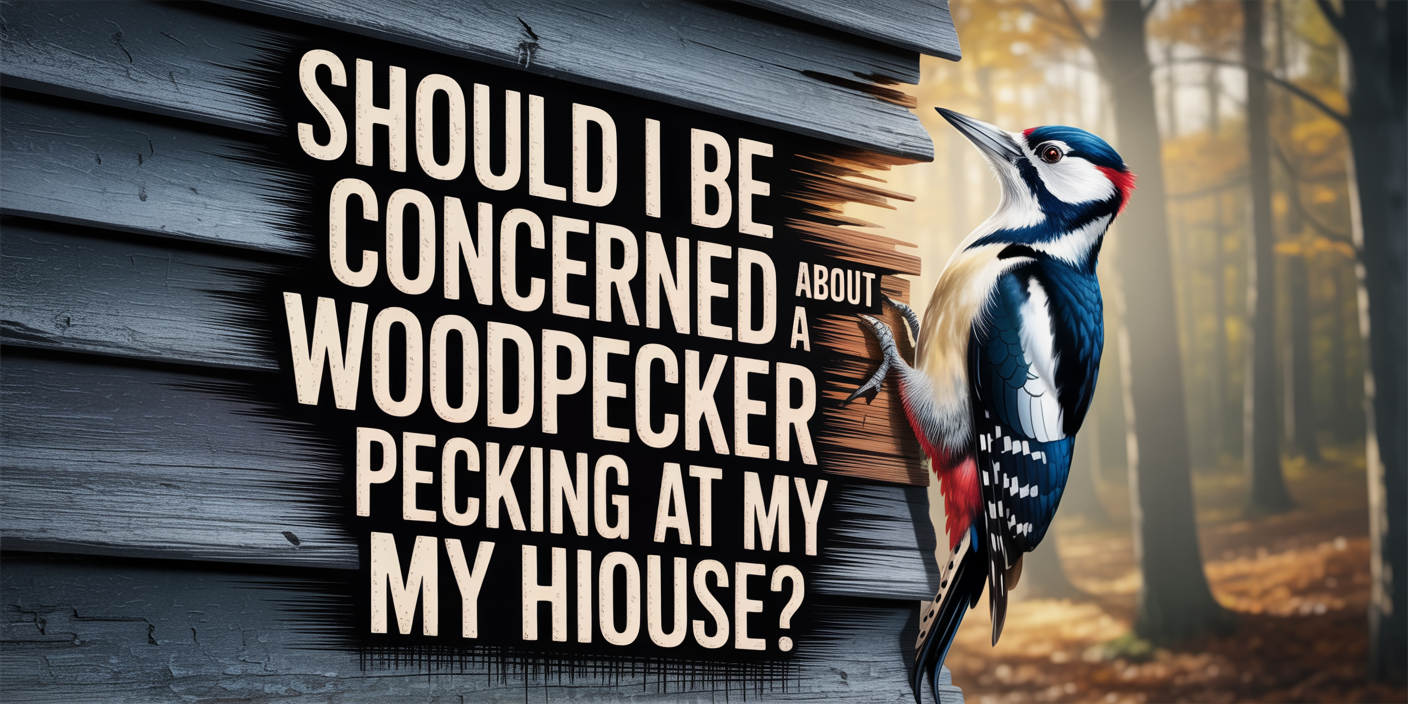“Yes, you should be concerned if a woodpecker is pecking at your house. That tapping sound might seem harmless, but it could signal hidden insect infestations, structural damage, or even lead to costly repairs if ignored.”
If you’ve ever heard a sharp tapping or rapid drumming sound outside your home, you’re not alone—especially in Phoenix. Woodpeckers are known to frequent residential areas across the Valley, and while the noise might seem like just another quirky bird habit, it could be the start of a bigger problem. These birds don’t just target trees. When food is scarce or nesting season hits, your home’s wooden siding, stucco, or eaves can quickly become their new favorite surface.
So, should you be concerned? Absolutely. A woodpecker pecking at your house isn’t just annoying—it can be a warning sign of insect infestations, attract more pests, and create expensive structural damage over time. Since woodpeckers are protected by law, it’s not as simple as chasing them off. That’s where understanding their behavior—and calling a professional like AAAC Wildlife Removal—becomes crucial.
Why Woodpeckers Peck at Houses in Phoenix
Woodpeckers don’t peck out of boredom—they’re usually after something. In many Phoenix neighborhoods, these birds are drawn to homes for three main reasons: food, nesting, or communication. Your wooden siding or even stucco walls might mimic the hollow sound of a dead tree, signaling a perfect place to drum or dig for insects.
Arizona’s hot, dry climate can also reduce natural nesting options, especially when trees are limited in urban areas. As a result, woodpeckers may shift to man-made structures where insects like carpenter ants or termites are already active. During mating season, the pecking ramps up as males drum to mark territory and attract mates, often choosing spots that create the loudest echoes—like your gutter, chimney cap, or trim.
Signs the Problem Might Be Serious
1. Clusters of Holes in Wood or Siding
A row of small, evenly spaced holes on your siding or fascia is a classic sign of woodpecker activity. These birds aren’t just pecking at random—they’re drilling for insects or starting to excavate a cavity for nesting. In Phoenix, where homes often have wooden trims or decorative cedar features, woodpeckers tend to favor these surfaces over less resonant materials.
Over time, what starts as a few tiny holes can expand into deep, unsightly damage. The issue becomes even more serious if the holes expose insulation or give access to other pests. Homeowners might also notice a trail of wood shavings or debris below the damage site, which means the bird is actively chiseling away at the structure. This kind of wear doesn’t just impact appearance—it weakens the material and drives up repair costs.
2. Persistent Drumming in the Same Spot
It’s normal to hear the occasional bird tapping outside. What’s not normal is when the sound happens at the same place, over and over again. Persistent drumming usually means the woodpecker is either marking its territory or has found an area with high insect activity, which is common in wooden trims and roof overhangs around Phoenix homes.
This repeated behavior creates more than just noise—it turns your home into a regular stop on the bird’s daily routine. That routine eventually leads to deeper holes, which invite moisture damage, mold, or other wildlife intrusions. Since woodpeckers are territorial, once one gets comfortable, it’s harder to convince them to leave without professional help.
3. Activity Near Vents, Eaves, or Rooflines
Pecking near rooflines, attic vents, or soffits often signals a bigger problem hiding behind your walls. Woodpeckers are expert foragers, and when they focus on these vulnerable areas, it’s often because they hear or sense insect movement inside the structure. Carpenter ants, termites, and beetles are common culprits that lure them in.
Aside from pecking damage, these areas also double as potential entry points for nesting. Once a woodpecker opens a hole near your attic or under your eaves, it’s not just the bird you have to worry about—other pests can follow. Addressing the underlying insect issue is just as important as deterring the woodpecker itself.
4. Early Morning Noises That Don’t Stop
If you’re being woken up by rhythmic tapping at the crack of dawn, especially during spring or early summer, there’s a good chance you’ve got a male woodpecker looking to impress. These birds love to amplify their sound by drumming on metal surfaces like chimney caps, gutters, or even AC units. The louder the echo, the better the bird feels about its chances.
This isn’t just a nuisance—it’s a signal that mating season is in full swing and your home has become a performance stage. Once this behavior starts, it can continue daily for weeks, disrupting sleep and putting stress on metal fixtures or painted surfaces. The sooner you intervene, the easier it is to redirect this behavior before it becomes routine.
What Damage Can Woodpeckers Cause?
While woodpeckers may look harmless perched on a tree, the damage they can cause to your home in Phoenix is anything but minor. When they peck into wood siding, trim, or even stucco, they create entry points that weaken your home’s structure. Over time, these holes let in moisture, lead to mold growth, and cause rot—especially during monsoon season. More than that, those open cavities often attract other unwanted pests, like termites, ants, bees, or even rodents. Aside from the physical issues, the constant tapping and visual damage can lower curb appeal and drive you nuts early in the morning.
Here’s a quick breakdown of the most common types of woodpecker damage:
- Structural damage to wooden siding, eaves, trim, and even foam-backed stucco
- Increased pest activity from insects and rodents entering through pecked holes
- Water damage and mold from rain seeping into exposed wall materials
- Cosmetic issues like chipped paint, visible holes, and unsightly wall patches
- Noise disturbances caused by early morning or repeated drumming near bedrooms
Why Woodpeckers Are Protected in Arizona
Many homeowners are surprised to learn that they can’t legally harm or remove a woodpecker on their own. These birds are protected under the Migratory Bird Treaty Act, a federal law that makes it illegal to capture, kill, or disturb woodpeckers without a special permit. That means using traps, poisons, or other harmful methods is not only unethical—it could get you in serious legal trouble.
Arizona follows this federal protection closely, and wildlife authorities may fine individuals who attempt unauthorized removal. The law exists to protect native bird populations, but it also means homeowners need to be extra careful when dealing with nuisance woodpeckers. The best solution? Work with a licensed wildlife professional who knows how to handle the issue humanely, legally, and effectively—like the team at AAAC Wildlife Removal in Phoenix.
Safe & Effective Ways to Deter Woodpeckers
1. Visual Deterrents That Disrupt Their Routine
Woodpeckers are startled by shiny, shifting objects. Hanging reflective tape, metallic streamers, or even old CDs around the affected area can throw off their sense of security. These materials catch the sunlight and move in the breeze, making your home feel less inviting to a bird looking for a quiet place to peck.
Pinwheels, mylar balloons, or aluminum foil strips are simple but surprisingly effective. The key is placement—install them close to the pecking site and rotate their location every few days. This unpredictability keeps the birds on edge and makes it harder for them to establish a pattern.
2. Sound-Based Deterrents and Noise Disruptions
If visuals aren’t enough, add sound. Motion-activated noise makers, wind chimes, or devices that emit predator calls can break up the woodpecker’s rhythm. These sounds disrupt their communication and make your property feel unsafe.
Ultrasonic repellents are another option for homeowners who prefer a quieter approach. They’re generally inaudible to humans but irritating to birds. While not foolproof on their own, they work well in combination with visual deterrents for a stronger, layered defense.
3. Physical Barriers and Bird Netting
When woodpeckers are targeting a very specific spot—like a fascia board, chimney, or trim—you might need to block access directly. Bird netting or hardware cloth can be mounted a few inches from the wall, creating a physical separation that birds can’t land on. It’s humane, effective, and widely used in persistent cases.
Be sure the barrier doesn’t trap moisture or damage your siding. A professional installer can ensure proper setup that preserves airflow and aesthetics while protecting your structure. This method is especially useful during peak nesting or breeding seasons when deterrents alone may not cut it.
4. Addressing the Underlying Insect Problem
Woodpeckers don’t always show up randomly. If your home has termites, carpenter ants, or other wood-boring insects, they’re likely the real reason the bird came knocking. These pests emit sounds and vibrations that woodpeckers can detect through siding or soffits.
Before you throw up every deterrent under the Arizona sun, it’s worth scheduling a pest inspection. If insects are living in your walls, the bird is just the messenger. Treating the source not only helps resolve the bird issue—it protects your home from even bigger damage.
Why Choose AAAC Wildlife Removal in Phoenix
Dealing with a woodpecker on your own can be frustrating, noisy, and legally risky. That’s where AAAC Wildlife Removal steps in. Our Phoenix-based team understands local bird behaviors, Arizona building materials, and the unique desert conditions that make homes more vulnerable to wildlife intrusions. We know exactly how to identify the root of the problem, apply legal deterrents, and protect your home from further damage.
Our services go beyond bird control—we offer thorough inspections, humane removal methods, pest identification, and long-term prevention plans. We don’t just chase woodpeckers away; we make sure they don’t come back. With fast response times, knowledgeable technicians, and a commitment to customer care, AAAC Wildlife Removal is the trusted choice for woodpecker issues in the Valley.
Conclusion: Don’t Ignore the Pecking
If a woodpecker is pecking at your house, it’s more than just an irritating noise—it’s a warning sign. Small holes can quickly lead to major repairs, insect infestations, or ongoing disturbances that impact your home’s value and peace of mind. In Phoenix, where dry weather and limited tree cover push wildlife toward residential areas, this kind of damage is increasingly common.
Instead of waiting for things to get worse, take action early. AAAC Wildlife Removal provides safe, legal, and effective solutions tailored for Arizona homeowners. We’ll help you stop the damage, solve the root issue, and protect your home for good. Call today for a woodpecker inspection and keep your home free from unwanted tapping.




